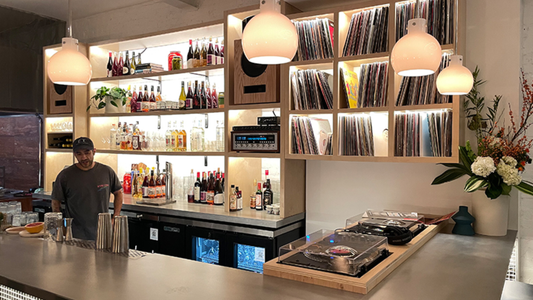
Stockholm — The Sound of Slowing Down
By Rafi Mercer
Something’s happening in Stockholm. Quietly, steadily, beautifully. Over the past few weeks, the data behind Tracks & Tales has started to hum — a noticeable rise in readers, new subscribers, and curious searches all coming from Sweden’s capital. And not just any readers — these are people looking for listening bars, for vinyl, for the slow sound.
It makes sense when you think about it. Stockholm has always been a city tuned to precision. It’s a place of clarity — of glass, light, and clean design. It moves efficiently, like a well-cut frequency. But perhaps that’s exactly why slow listening is finding its moment there. Because even in a city built for speed and innovation, people are beginning to crave depth again.
You can feel it in the cultural rhythm. Cafés that used to blast playlists now host curated vinyl evenings. Design studios talk about “sound identity” the same way they talk about typography or materials. Audiophile showrooms are becoming places to gather, not just shop. There’s a quiet rebellion brewing — one that replaces the rush of noise with the richness of tone.
Stockholm understands craft. That’s always been its language. Whether it’s the curve of a chair, the weight of a glass, or the engineering of a turntable arm, Swedish design has always been about less, but better. That mindset translates perfectly into the new wave of listening culture — the idea that music, too, can be designed into space, that a room can be tuned like an instrument.
It’s no surprise, then, that Swedish listeners are discovering Tracks & Tales in growing numbers. They get it — that sound isn’t background, it’s atmosphere. It’s not about listening to more, it’s about listening better.
I think back to the first time I visited Stockholm. The air felt crisp enough to hear. Even footsteps had reverb. You could almost imagine the whole city as one extended piece of minimalist jazz — clean basslines of metro trains, brushed cymbals of bicycle bells, the piano of distant conversation drifting across the water. Everything balanced, everything intentional.
Now imagine that same city learning to slow its tempo — to lean into the low end, to turn attention from clarity to warmth. That’s what’s happening right now. The fast-thinking city is learning to listen slow.
The venues will come next — I can sense it. Spaces where vinyl meets architecture, whisky meets light, and conversation carries like melody. Maybe in Södermalm or Vasastan, where small bars already hum with creative rhythm. Maybe something modern, minimalist — birch wood, warm amber glow, a perfectly balanced tonearm tracing the groove.
If Tokyo and London taught us what the listening bar could be, Stockholm might teach us what it looks like when design and sound truly converge. A bar where acoustics and aesthetics are treated with equal care. A space that feels Scandinavian in restraint but global in soul.
And it’s not just about venues — it’s about a mindset shift. Slow listening aligns perfectly with Sweden’s deeper values: sustainability, mindfulness, intentional living. The same culture that gave us fika — that sacred pause for coffee and conversation — is now finding its sonic counterpart. Maybe we’re witnessing the beginning of Ljudfika — the pause to listen.
For us at Tracks & Tales, it’s more than a statistic. It’s confirmation that this movement — this quiet reawakening of how we hear — is becoming global. Stockholm isn’t just another city on the map; it’s a sign that the language of listening is universal.
So to everyone reading from Sweden — tack så mycket. Thank you for tuning in. Keep listening, keep pausing, keep building the rooms where music matters. The sound of Stockholm is changing — not getting louder, but deeper.
Rafi Mercer writes about the spaces where music matters.
For more stories from Tracks & Tales, subscribe, or click here to read more.







